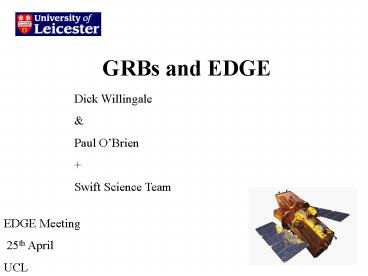GRBs and EDGE - PowerPoint PPT Presentation
1 / 22
Title: GRBs and EDGE
1
GRBs and EDGE
Dick Willingale Paul OBrien Swift Science
Team
EDGE Meeting 25th April UCL
2
Standard Fireball Model
External Shock
Internal Shock
The outflow slowed down by the surrounding
medium
Collisions between different parts of the flow
X
O
GRB
R
Afterglow
3
Afterglow parameters
- The afterglow can potentially give us information
about - The explosion energy, E0 , and explosion
mechanism - The density and/or density profile of the CSM,
n(R) - The jet collimation angle, ?j
- Shock physics
- But we need to understand the afterglow
- The afterglow might contribute vital information
required to produce a - GRB Standard Candle
4
Prompt Gamma-ray Emission by Internal Shocks
luminosity
External Shock emission Typical freq. X-ray-gt
optical -gt radio
GAP in observations
pre-Swift Era
time
10 sec
A few hrs
Days-months
5
The Swift Era e.g. GRB 061121
Kim Page et al. ApJ, 2007
6
Functional Fitting of GRB X-ray decay curves
observed by Swift
6 temporal 4 spectral
7
80 have fast prompt decay 2nd component ?
afterglow
8
20 slow prompt decay ? afterglow
The majority of the X-ray decay curves exhibit
flares, some at late times. These are most likely
an indication of continued (late) activity from
the central engine.
9
- Currently we have 150 GRBs with BAT XRT
detection. Essentially all GRBs can be detected
by the Swift XRT if we slew quickly and if there
are no observing constraints. - Many are bright enough early on to allow EDGE to
detect WHIM/ISM/IGM absorption features.
10
I - Prompt emission
internal shocks? Poynting outflow?
relativistic beaming
relativistic expanding fireball
11
II - Prompt decay
delayed off-axis/high latitude emission
Prompt source switches off suddenly
12
III - Plateau late emission hump
synchrotron emission from external shock
fireball expansion slows down
interaction of fireball with CSM - external shock
develops energy injection from the fireball
13
IV - Afterglow power law decay
synchrotron emission spectrum gradually red-shift
ed
beaming angle expands as external shock slows down
fireball dead
14
V - Afterglow post jet-break
synchrotron spectrum still being red-shifted but
fades faster because edge of jet now visible
beaming angle now larger than jet
15
Phases of decay - Times
Prompt emission stops Tp
External forward shock becomes visible TFS
Final decay Starts Ta Late break Tb
16
- Two times Tp and TFS
- two radii and two gammas Rp, RFS,Gp,GFS
- Analysis of 10 GRB decay curves gives
- Gp/GFS2 and RFS/Rp4
- Rp1015-1016 cm
- If prompt emission is synchrotron require
Rp3x1017 cm - If prompt emission is synchrotron-self-Compton
then size is OK but should see an optical flux
many orders of magnitude brighter than observed
17
What is the prompt emission?
- Baryonic outflow and internal/external shocks
cant produce the prompt emission - Require different shock physics or
- Magnetic field dominated outflow dissipation in
outflow produces the gamma-ray prompt emission - See Kumar et al. MNRAS, 2007
18
Intrinsic (source frame) spectra of the prompt
emission
19
The Amati relation between the peak photon energy
and isotropic energyUnderstanding this could be
a key to unlock the mystery of the prompt emission
20
What is the final X-ray power law decay? As the
outflow slows we expect a simple coupling between
the temporal and spectral indices.
post jet break pre jet break
energy injection? 060218 oddball
21
Transition from plateau to finalpower law decay
getting Softer getting harder
22
Time of transition Ta ?
Post jet break Energy injection
23
Extra break Tb gt Ta (blue)
Slow prompt ? final decay
24
Potential jet breaks2 in accord
withpre-Swiftoptical jet breaks
25
Decays where an expected jet break is absent
26
Decays where as expected jet break is absent
27
Collimated energy E?
Optical jet breaks - Frail/Bloom/Ghirlanda
energy offset factor 34 (tjet110Ta)
Lower limits using Tatjet
28
Ghirlanda relation type II?
end of X-ray plateau tjTa
similar gradient
end of X-ray light curve tjTmax
Optical Jet Breaks tjopt
energy offset factor 26 (tjet90Ta)
29
Summary of Swift results
- X-ray afterglows can stem from the plateau (80
GRBs) and/or the initial decay of the prompt
emission (20 GRBs) - Only 50 of the final X-ray afterglows conform to
the expectations of the standard model energy
injection? - Some afterglows get harder as they evolve not
expected from the standard model - 3 possible jet breaks identified in accord with
pre-Swift optical jet breaks - 8 X-ray decays - expected jet break is absent
- Study of the initial prompt decay indicates that
the a baryonic shock may not be responsible for
the emission - The Amati relation still holds but what is the
correlation between Epeak and Eiso really telling
us?
30
Observational requirements for the future
- Full time coverage from prompt to final afterglow
decay a few seconds to weeks! We need fast
slewing. - Simultaneous multi-waveband observations to track
the evolution of the SED. Again we need fast
slewing. - Measurement of the hard tail of the prompt
emission spectrum ? Epeak value. We need a hard
X-ray detector. - Accurate positions for finding the optical
afterglow, identifying the host galaxy, getting
the redshift - Large collecting area to provide excellent
statistics for spectral/absorption studies early
on. - Measurement of both prompt and afterglow
parameters to provide a route to the GRB
Standard Candle.































